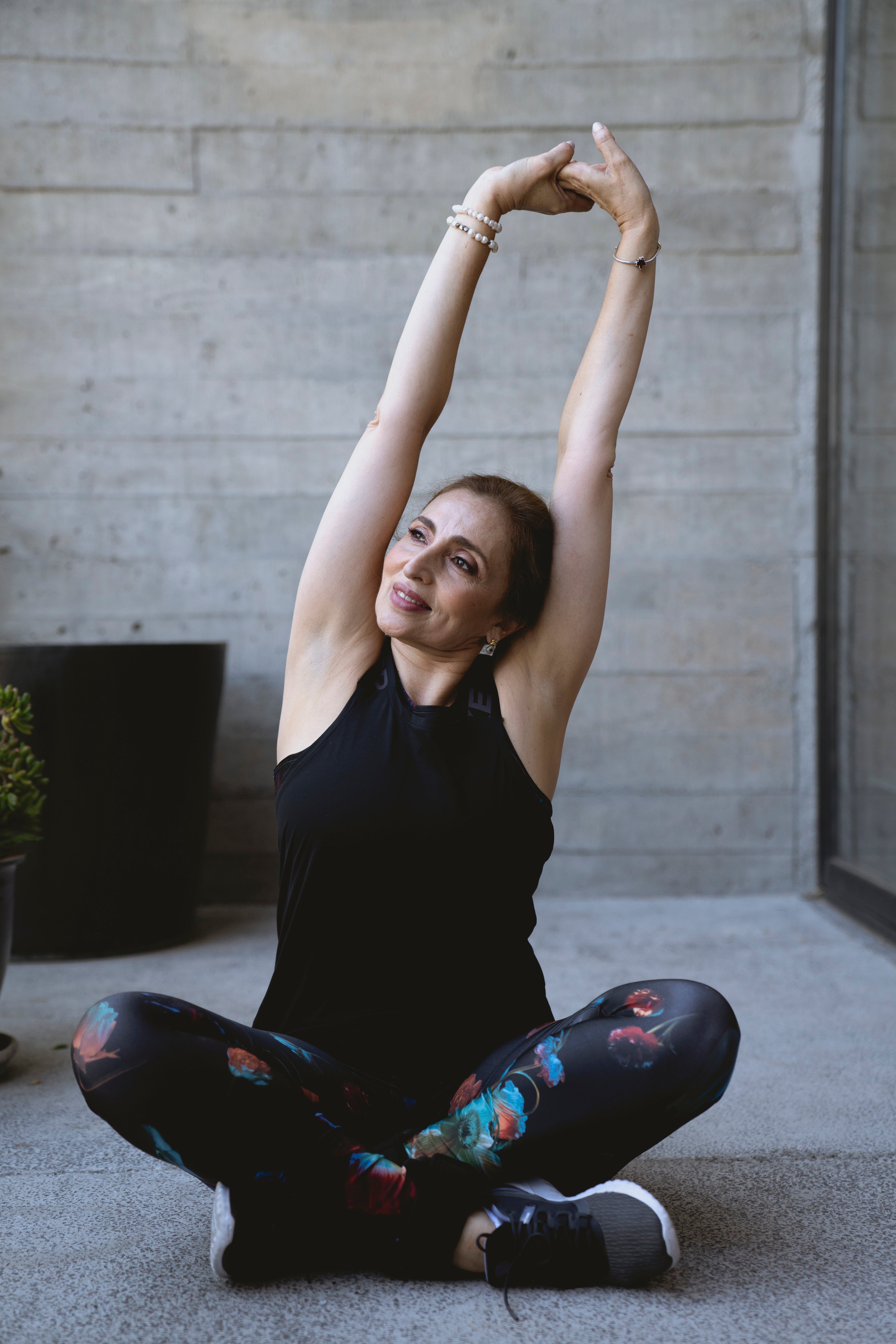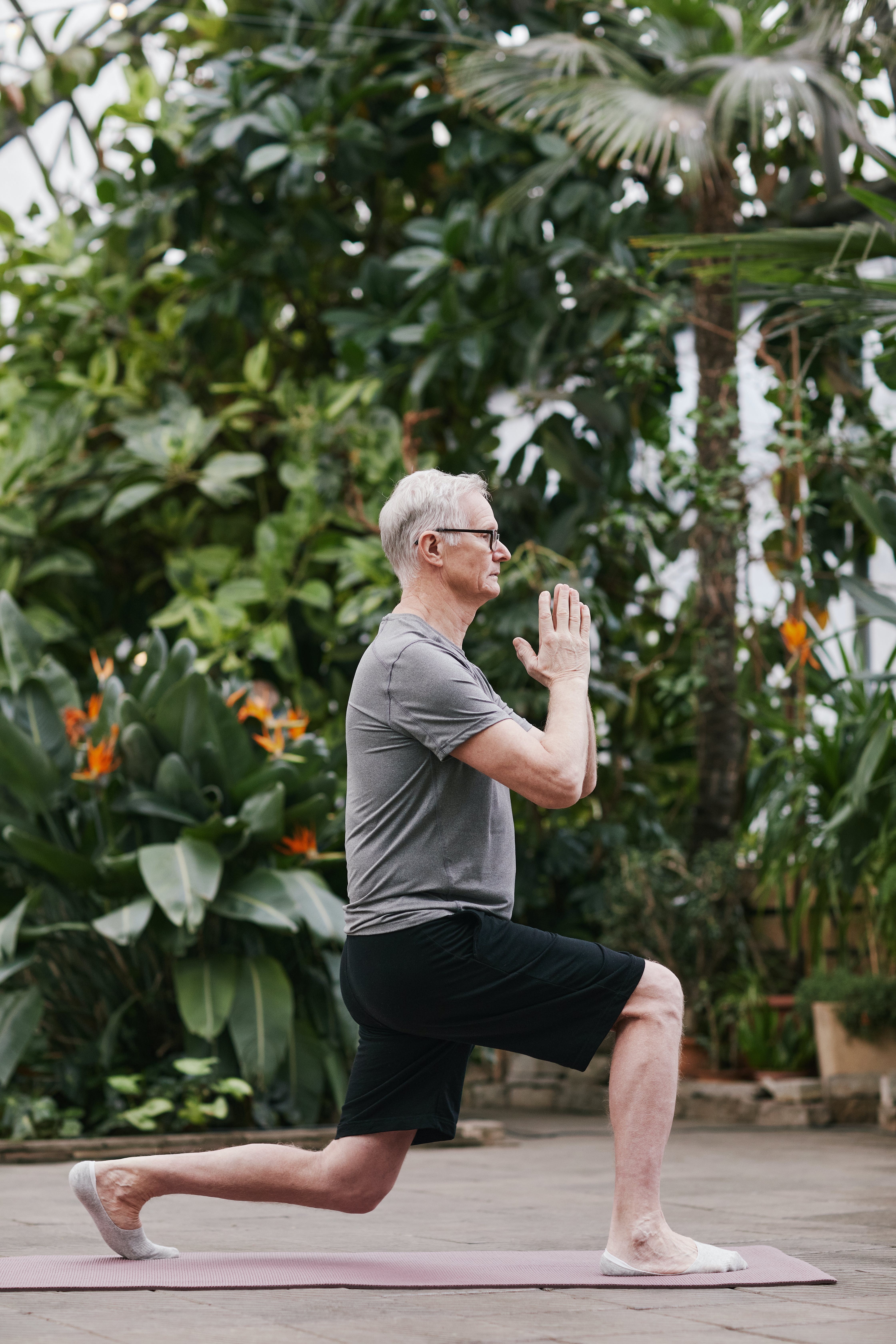Maybe fifteen minutes into my first yoga class – exhausted, post-gym, arms trembling, lungs burning – I realized – too late – that yoga is not stretching.
So I’m writing this to save you from the same fate.
Understanding the differences – and similarities – between yoga and stretching will help you get the most from both.
Now, you’ll likely do some stretching during yoga. And you might adopt a yoga pose while stretching. However, there are big differences in terms of philosophy, your approach, goals, how long you might do them, and their potential benefits.
Let us begin with the similarities.
Similarities Between Yoga and Stretching
As with many ideas, concepts, and practices, stretching and yoga overlap.

People do both yoga and stretching to help:
- relieve muscle tightness and tension
- improve posture, not least of all via improvements to spinal flexibility
- improve flexibility
- improve circulation, which may give you more energy
- lower blood pressure
- manage muscle pain
- loosen stiff joints
The Differences Between Yoga and Stretching
While yoga and stretching achieve many of the same goals and may employ similar techniques, stretching is a physical movement intended to lengthen a muscle to improve flexibility and range of motion.
Dynamic stretching refers to controlled movements that stretch muscles.
Passive stretching refers to holding a static stretch.
On the other hand, yoga has a rich history and takes a holistic approach, incorporating physical, mental, spiritual, and emotional planes.
Physical
Yoga Comprises Mobility, Flexibility, and Strength
Stretching can improve flexibility and increased flexibility might help your joints maintain a healthy range of motion. Yoga – or the asana practice, the physical poses – can help you increase flexibility, mobility, breath control, and strength at the same time.
This multifaceted approach is one of the aspects that makes yoga effective for varied health goals for a range of body types, ages, and goals.
Most Popular Yoga Styles Can Be Considered Moderate Physical Activity
When people stretch, they typically do so before or after a workout – whether aerobic or strength-based – or simply to loosen the muscles. It’s not something that increases strength or significantly raises your heart rate.
While yoga wouldn’t be considered an intense workout – with exceptions like hot yoga or power/vinyasa yoga – it is considered an alternative, low-impact activity that can help people meet moderate exercise goals.
Mental
Yoga Improves Cognition and Mental Clarity
Yoga practice is known to improve your cognition and mental clarity. Scientists continue to document the evidence for yoga’s positive effects on brain structure and function. A review of 11 studies demonstrated yoga’s positive influence on the amygdala (which helps process emotions and links them to memories, learning, and senses), hippocampus (which plays a major part in learning and memory), prefrontal cortex (which regulates thought, actions, and emotions), cingulate cortex (linked to emotional responses to actions and behavior), and brain networks.
Yoga Incorporates Breathwork
Breathwork or pranayama is one of the key differences between stretching and yoga.
Pranayama – breathing tied to meditation and movement – helps you tune into your body and mind and move energy.
You breathe when stretching, too. Advice is typically to breathe normally while stretching. You might also exhale to deepen a stretch. However, this automatic breathing doesn’t always have the same focus, intention, or effect as yoga’s purposeful breathwork.
Physical Yoga Can Be More Complex than Stretching
While yoga is accessible to absolute beginners, it can become complex and challenging as you try more advanced asanas. It may require many hours over several years to safely and beneficially practice more advanced physical flows and poses.
Stretching, however, tends to start and end relatively simply.
Spiritual
Yoga is a Holistic Practice
With its origins in ancient India, yoga is amongst other things a spiritual practice that helps connect the body, mind, emotions, and greater world.
Unlike stretching, which is more mechanical, even the most Westernized yoga usually includes breathwork and mindfulness, calming the mind, boosting awareness, enhancing emotional wellness, and helping us make connections in ways that are beyond the physical.
Emotional
Yoga Can Lead to Emotional Release
Yoga may release emotions, leading to yogis laughing or crying on the mat, finally allowing a deep knowing to emerge. The combination of physical postures (hip openers, in particular, are often linked to emotional release), meditation, silence, and raising awareness can bring about tears of relief or sadness, and also has the potential to uncover buried, hidden, or otherwise obscured emotions.
While deep stretching can activate the parasympathetic nervous system and affect your emotions, if you’re crying during stretching, you’ve probably torn a hamstring.
Yoga Stretches
The relative simplicity of stretching is not a bad thing. Stretching is great at targeting specific muscle groups and improving mobility.
As we’ve seen, yoga includes stretching but also goes far beyond it. Sure, there are yoga classes that resemble stretching sessions – classes that focus on a particular muscle or muscle groups, like wrists, back relief, and so on. There are micropractices so you can stretch at work or when you don’t have much time. However, you can also rely on yoga for a more holistic experience.
However you feel about it, yoga has reached this “a la carte” phase where people choose what to take from it. The same is true of many other practices, disciplines, and religions today. So people can benefit from yoga for stress relief, improved breathing, increased strength and physical health, connection to nature, a spiritual awakening or – they can just come to yoga for the stretching. They may also want all of the above!

Here are some key DYWM classes to give you a taste of how yoga can fulfill your stretching needs.
- Subtle Joint Movements — Sarada introduces sukshma vyayama, the ancient system of yogic practices that features rhythmic stretching movements to remove energy blockages and loosen joints. Martial artists will appreciate this before training.
All you need is “your mind and body present on the mat.”
- Stretching Your Lower Back in Flexion — This is an effective stretch for those with particularly tight muscles around the lower back or hyperlordosis (an exaggerated curvature of the lower back).
- Happy Baby / Dead Bug Pose — This is a very quick and powerful stretch for the lower back and hamstrings. Take it easy as this stretches your erector spinae muscles and gets deep into the lumbar vertebrae.
- 5-minute Stretching Routine for the Wrists — Here’s a stretch that you can do at your desk. You might also consider a short yoga routine to relieve symptoms of wrist pain or carpal tunnel syndrome.
- Strengthening & Stretching Routine for the Rotator Cuff — You’ll need a soft block, pillow, or other head support for this one. You might also like a light weight you can grip and lift with one hand.
This routine stretches and strengthens your supraspinatus, infraspinatus, tere minor, and subscapularis, to heal or prevent damage to your rotator cuff.
- Fish pose — We don’t always pay attention to tension in our chests and throats. This pose is a powerful stretch that opens up your heart and throat. Fiji includes variations for more experienced or more flexible practitioners who want to push the stretch further.
- 14-Day Yoga Challenge: Day Thirteen — True Twists — In addition to stretching and strengthening your shoulders and legs, Fiji introduces “true twists” in this intermediate yoga class.
So, Is Yoga Better Than Stretching or Not?
Yoga and stretching aren’t competing. They’re complementary. You can do both. You just need to think about which approach suits you best.
People often do dynamic stretches before a workout. Passive stretches may help recovery post-workout.
If and when you’re ready, yoga does everything that stretching does and more, but its approach tends to be more all encompassing .
You could do yoga as a prelude to more intense physical activity or exercise. You can do a yoga routine to cool down. Or you can just do yoga, as an activity in and of itself.
And, finally, yoga doesn’t need to involve stretching at all! Ultimately, it’s a way of approaching life.
Yoga has the physical benefits of stretching, such as improving flexibility and mobility, but it also works on our physiology, mind, and emotions, with the ability to boost the immune system, relieve stress and anxiety, improve cognition, increase muscle strength, and much more, partly depending on how much time you spend doing it per week.
Whether you veer toward stretching or yoga, keep an open mind about both and maintain your physical awareness to discern what’s right for your body, mind, and goals.



Comments
Existing Comments